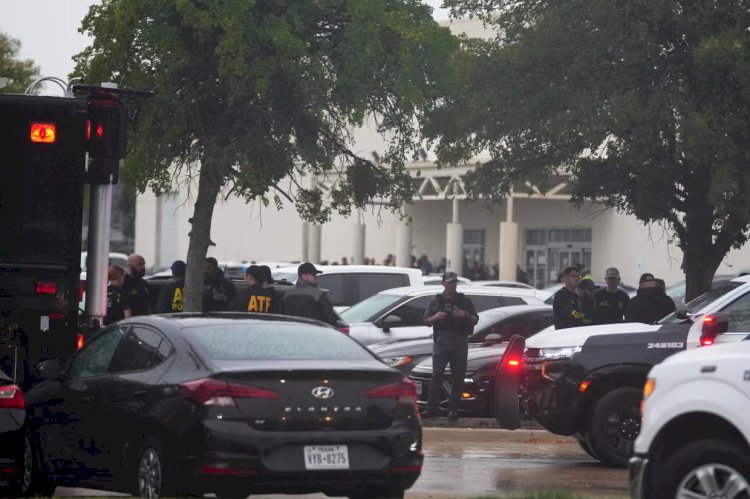Deadly Dallas Ambush: Sniper Kills Two ICE Detainees in Premeditated Attack, Prompting Security Crisis
Two ICE detainees killed and one injured in a premeditated sniper attack on the Dallas Field Office. Authorities investigate the motive behind the calculated ambush and the rising tide of violence targeting immigrant communities and federal facilities.

DALLAS, TX — A calculated and devastating attack on a U.S. Immigration and Customs Enforcement (ICE) facility in Dallas on Wednesday morning left two ICE detainees dead and a third hospitalized. The bloodshed concluded when the suspected shooter, described as a sniper, died from a self-inflicted gunshot wound on the roof of a nearby building, raising urgent questions about security protocols and the rising tide of violence directed at immigration enforcement agencies.
The ambush, which authorities are calling a premeditated and pre-planned assault, occurred at approximately 6:40 a.m. local time at the ICE field office located on North Stemmons Freeway. The location, crucial for immigration processing, deportations, and temporary holding, became a sudden scene of chaos as multiple rounds were fired into a sally port area where detainees were being brought into the building, possibly during processing or transport.
The Attack and Response
Law enforcement sources indicated the attacker, whom police have only described as a white male armed with a rifle, took up an elevated position—specifically the roof of an adjacent building—to carry out the shooting. The elevated vantage point allowed the shooter to fire down into the facility's restricted entry area, targeting an unmarked van carrying the detainees.
The Dallas Police Department (DPD) was immediately called to the scene to assist an officer on the freeway, with the FBI quickly dispatching agents to take control of the federal investigation. As federal agents closed in on the shooter's position, the assailant took his own life.
By mid-morning, officials confirmed the tragic toll: two ICE detainees had died, and a third was in critical condition at a local hospital. Crucially, an ICE spokesperson confirmed that all three victims were detainees, distinguishing this attack from other recent incidents where law enforcement officers were the primary targets.
A Focus on the Victims
The fact that the victims were ICE detainees immediately placed their status—and the nature of the facility—under scrutiny. Homeland Security Secretary Kristi Noem, in an early social media statement that was later corrected, initially misidentified the location as a detention facility. Officials clarified that the Dallas site is a Field Office, used for administrative processing, a distinction that carries significant weight.
As field offices, these facilities are government-run and do not typically house long-term detainees, a function usually contracted out to private detention centers. The victims, therefore, were individuals likely in the early stages of immigration proceedings, potentially including those with pending asylum claims or temporary legal status. Being detained by ICE does not inherently mean a person is unlawfully in the country, adding a layer of tragic complexity to the loss of life.
The acting ICE Director, Todd Lyons, spoke to the incident, confirming that three individuals were shot and transported to the hospital. "It could be employees, it could be civilians that were visiting the facility, it could be detainees," he initially noted before later updates confirmed the victims’ status.
Premeditation and Motive
The speed and precision of the attack, particularly the use of a sniper position, led authorities to quickly declare the shooting a "premeditated and pre-planned attack." Investigators are now digging into the shooter's background, social media, and known associates in a bid to confirm their identity and, more importantly, establish a clear motive.
While the motive remains unknown, Homeland Security Secretary Noem pointed to the broader political climate, stating that ICE law enforcement is "facing unprecedented violence against them." She added that the facility itself had been the target of a previous bomb threat, a grim reminder of the tense and often hostile environment surrounding immigration enforcement in Texas.
The DPD’s preliminary investigation, confirmed via a social media post, noted that the suspect had opened fire from an adjacent building. FBI sources suggest the shooter may have even surveilled the location prior to the attack. Their current focus is on understanding the shooter's "network" and identifying any potential accomplices or like-minded individuals who may have encouraged or aided the violent act.
Security and Future Implications
The nature of the ambush—a sniper firing from an outside, elevated structure—has dramatically amplified security concerns across all federal immigration facilities. Experts warn that defending against attacks launched from adjacent private or commercial buildings presents a formidable challenge for facility security designers and personnel.
The incident comes amidst heightened political tension and fear within the immigrant community in Texas, stemming from recent aggressive immigration enforcement tactics. The fact that the attack targeted and killed migrants, rather than ICE agents, adds a disturbing element to the narrative of political violence in the region, leaving open the possibility that the assailant's motive was a targeted act against the immigrant community itself.
As the Dallas Field Office recovers and the investigation deepens, federal agencies will be forced to re-evaluate their security posture nationwide. The tragic, calculated deaths of the two detainees have moved the conversation beyond the usual concerns over violence against law enforcement and squarely into the realm of how government facilities can protect the vulnerable populations—the detainees—passing through their gates. The investigation into who the shooter was, and what drove the horrific act, is now the central focus for a city grappling with the aftermath of an unprecedented act of domestic extremism.

 Selina Smith
Selina Smith 















